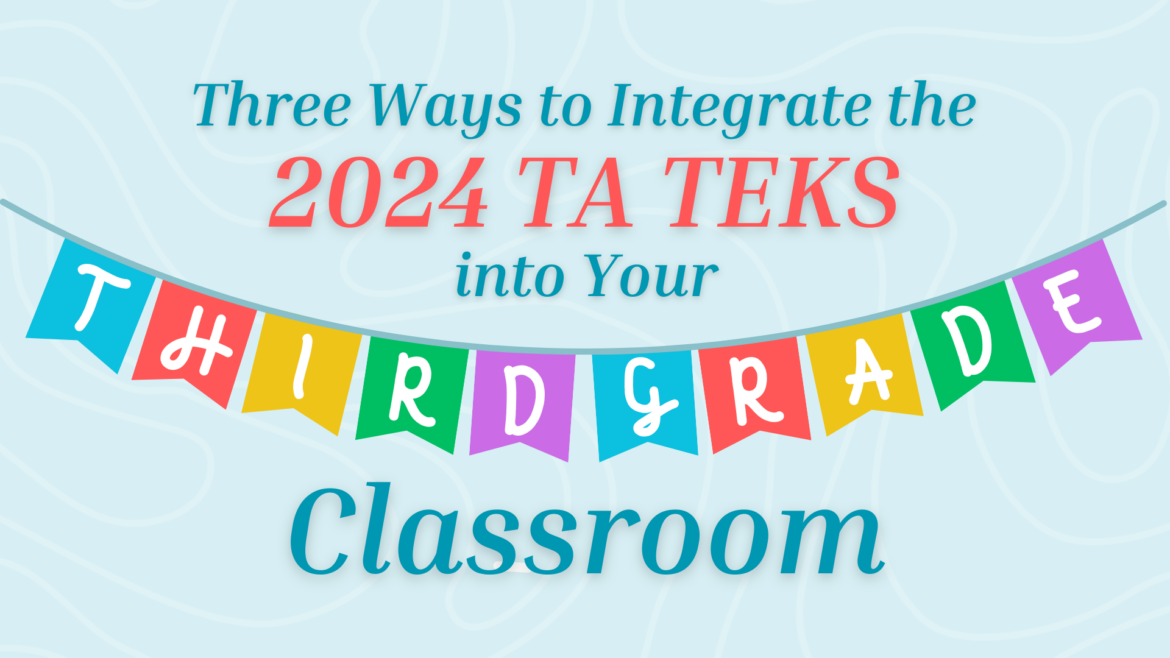The Texas State Board of Education’s new Texas Essential Knowledge and Skills for Technology Applications for K-8 students has educators working to update their lesson plans to meet overarching educational goals. This change can feel overwhelming, but implementing the new 2024 TA-TEKS into your elementary coursework just takes some creativity and a little elbow grease!
NOTE: For information on TA-TEKS for students in kindergarten, first, and second grade, check out our Technology Applications: TEKS for Grades K-2 online course. Keep an eye out for expanded grade level offerings in the near future.
2024 TA TEKS Updates
The new TEKS list was formally adopted in 2022, but does not take effect until the 2024-2025 school year. With the former TEKS in place since the Fall 2012 semester, members of the board decided it would be more beneficial to set goals for each grade level, rather than banding several grades together as they had done in previous years. Third-grade TEKS, specifically, represent five core strands that include:
- Computational thinking
- Creativity and innovation
- Data literacy, management, and representation
- Digital citizenship
- Practical technology concepts
The new set of TA TEKS will place a heavy emphasis on problem solving. And, for educators, that emphasis is a great place to focus when creating lesson plans for the new year and beyond.
Three Ways to Use the New 2024 TA TEKS in Your Classroom
When crafting lessons that not only weave technology into core educational goals, but that also follow the required benchmarks set by the state, it’s important to emphasize critical thinking and digital literacy in an age-appropriate way.
Keep in mind that, even though we’ve honed in on ideas for third graders in this specific article, these lessons can be tweaked and reshaped to fit any late-elementary grade levels.
Encourage Creativity with Digital Storytelling
2024 TA TEKS strands involved:
- Creativity and innovation
- Practical technology concepts
To enable students to utilize technology in fun and creative ways, help them create and share multimedia stories. Start by introducing the concept of digital storytelling. At this point, students should be familiar with the general cadence and structure of their favorite books, so you may consider choosing an existing story to use as the basis for an example project where you share a tale they know and love in a new way. You may also want to provide a list of themes or prompts to help your students brainstorm or encourage them to think outside the box!
Have students utilize storytelling apps like Storybird or Book Creator to build their creations, complete with text, images, and even audio clips. Then have them share their finished projects with the class to encourage public speaking and presentation, skill building that they’ll need later on.
Spark Interest with Digital Research Basics
2024 TA TEKS strands involved:
- Computational thinking
- Data literacy, management, and representation
- Practical technology concepts
Help students develop priceless research skills by utilizing digital tools and resources to learn more about a fun topic of your (or their) choice. Start by teaching students how to gather accurate data from reliable sources. At a third-grade level, steer them towards education-focused sites like National Geographic Kids or Smithsonian Kids and help them learn to navigate using the search bar and menu.
You may even want to take it a step further and teach them how to evaluate online sources for credibility and accuracy. Make it fun with some outlandish examples. There was a period in the late 2000s where a certain site listed George Washington as a ninja who had a black belt, so there’s bound to be a silly example to highlight your point somewhere on the web. If you can’t think of one, check the the “Save the Tree Octopus! Helping Students Develop Critical Thinking Skills” lesson plan. Don’t forget to finish the project by having students create a slide deck and present their findings for an added educational bonus.
Foster Critical Thinking with Digital Citizenship and Safety
2024 TA TEKS strands involved:
- Computational thinking
- Digital citizenship
Build on the basic digital citizenship and online safety knowledge students already possess at a higher level each school year. In third grade, start with a discussion on what being a good digital citizen means. You may consider subjects like respecting others online and protecting personal information. Include positive and negative examples in your lesson, and invite your students to deduct whether the example is one of good digital citizenship or not.
You can also role-play scenarios that highlight safe online behaviors when students encounter potentially unsafe situations online. Include tips on what to do if they encounter or experience cyberbullying, phishing, and more. There are several interactive websites that simulate real-world scenarios that your students can use for additional practice like the FBI’s Safe Online Surfing Internet Challenge.

